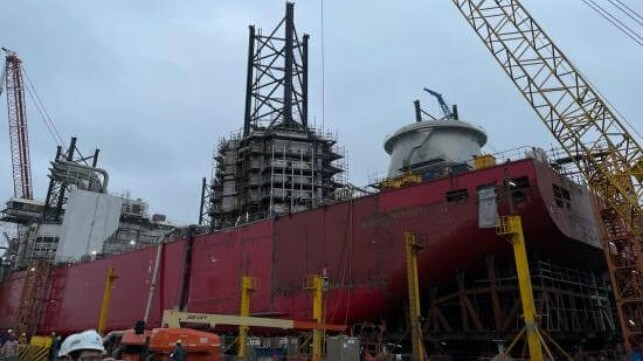First Look at U.S.’s Only WTIV Under Construction in Texas for Dominion

The first image appeared of the much-celebrated wind turbine installation vessel being built for Dominion Energy at Seatrium AmFELS shipyard in Brownsville, Texas. The vessel will be the first, and possibly only, Jones Act-compliant wind turbine installation vessel and is slated to be used with Dominion’s Coastal Virginia Offshore Wind project as well as charters to Ørsted for installation of some of its U.S. projects.
Named Charybis, the vessel was billed as state-of-the-art, and a major advancement for the U.S. industry. There was a lot of discussion about the vessel when its keel was laid in December 2020, but since then it has received less attention as reports surfaced that it was running behind schedule and over budget.
The U.S. Department of the Interior is providing the first glimpse of the vessel today, March 20, showing the status of construction. Principal Deputy Assistant Secretary for Land and Minerals Management Dr. Steve Feldgus, Bureau of Ocean Energy Management Director Elizabeth Klein, and Bureau of Safety and Environmental Enforcement (BSEE) Deputy Director Paul Huang toured the construction today at the shipyard in Texas.
Contained within Dominion Energy’s annual report filing to the U.S. Securities Exchange Commission in late February are details including a $625 million cost estimate, up from the around $500 million reported in 2020. Original reports said the vessel would be ready around the end of 2023, although BOEM commenting on today’s inspection said that it has an anticipated construction completion by late 2024 or in 2025.
It was reported in 2021 that the installation vessel was being chartered to Ørsted for work on the Revolution Wind and Sunrise Wind projects in the Northeast U.S. Both of those projects are still moving forward although potentially delayed by financial and supply challenges, but Ørsted is proceeding with the projects after having canceled others in the United States.
BOEM said after its tour that the Charybdis when completed will be based out of Hampton Roads, Virginia, and operated by a U.S. crew to support the installation of Coastal Virginia Offshore Wind. Dominion's construction plan approved by BOEM calls for the vessel to be deployed between Q2 2025 to Q2 2027 at the Virginia wind farm construction site.
The Charybdis was designed to be able to handle the current and next generation of wind turbines going up to approximately 14.7 megawatts and larger. The vessel will have a length of 472 feet, making it one of the largest WTIVs yet built, and built with more than 14,000 tons of domestic steel, mostly sourced from Alabama, North Carolina, and West Virginia. It will be capable of the installation of foundations for the turbines and other heavy lifts including the turbines.
Built in the U.S., the vessel has unique advantages as it will be fully compliant with the Jones Act cabotage rules. The Charybdis will be able to make frequent trips to U.S. ports to load and transport materials to the installation sites. Other U.S. projects are using an alternative approach of chartering foreign vessels which are precluded from transporting the materials and which will be dependent on barges and feeder operations to move materials from the staging sites at the wind ports to the offshore locations. Dominion told BOEM that it expects Charybdis to be
"sought after for offshore wind turbine installation contracts for other projects in the U.S."
Last year, the Biden administration highlighted that the wind sector led companies to announce 18 offshore wind shipbuilding projects as well as investments of nearly $3.5 billion across 12 manufacturing facilities and 13 ports to support the American offshore wind supply chain.
In addition to the Charybdis, the vessels include a rock installation vessel, a SOV, and crew transfer vessels. Last week, Maersk Supply Service and Edison Chouest announced an agreement for the construction of tugs and barges for their feeder system.
The vessels for the offshore wind sector are being built at shipyards ranging from Texas to Pennsylvania, Florida, Louisiana, New York, Massachusetts, Michigan, Rhode Island, and Wisconsin. The first of the crew transfer vessels have been completed and delivered while the SOV was recently moved from the building hall in preparation for it to be floated.
